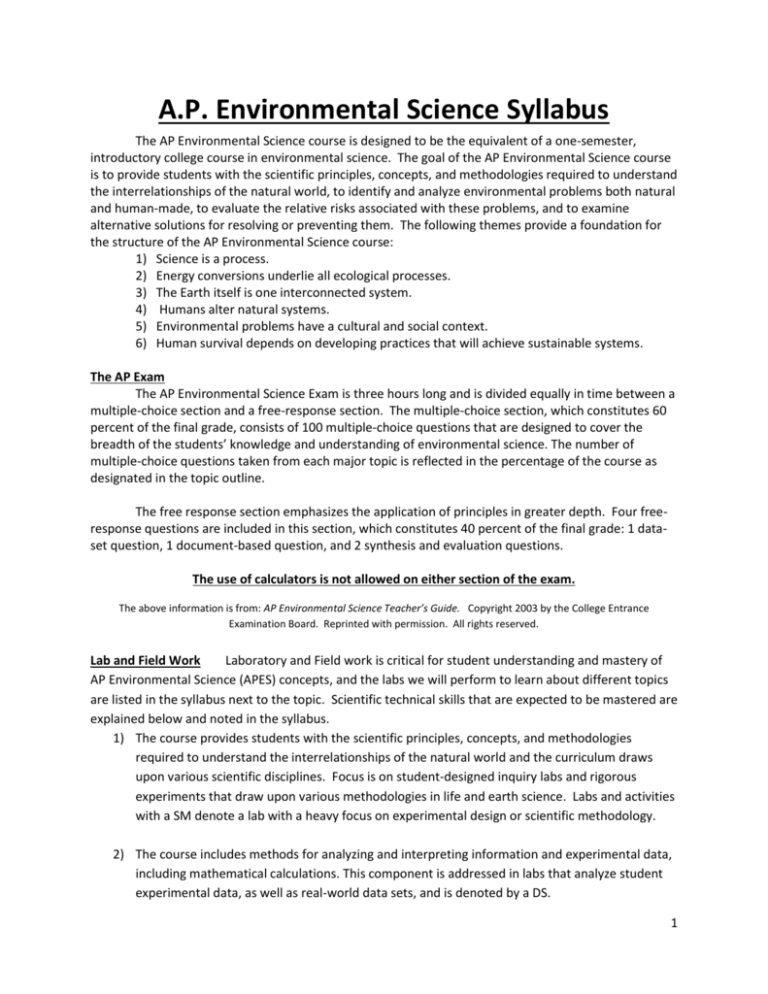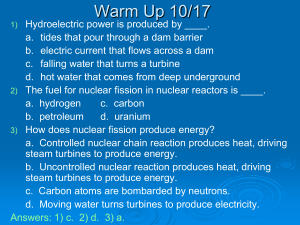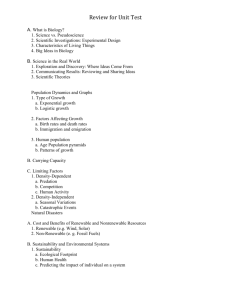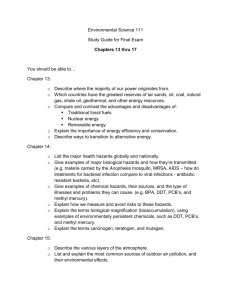
A.P. Environmental Science Syllabus
The AP Environmental Science course is designed to be the equivalent of a one-semester,
introductory college course in environmental science. The goal of the AP Environmental Science course
is to provide students with the scientific principles, concepts, and methodologies required to understand
the interrelationships of the natural world, to identify and analyze environmental problems both natural
and human-made, to evaluate the relative risks associated with these problems, and to examine
alternative solutions for resolving or preventing them. The following themes provide a foundation for
the structure of the AP Environmental Science course:
1) Science is a process.
2) Energy conversions underlie all ecological processes.
3) The Earth itself is one interconnected system.
4) Humans alter natural systems.
5) Environmental problems have a cultural and social context.
6) Human survival depends on developing practices that will achieve sustainable systems.
The AP Exam
The AP Environmental Science Exam is three hours long and is divided equally in time between a
multiple-choice section and a free-response section. The multiple-choice section, which constitutes 60
percent of the final grade, consists of 100 multiple-choice questions that are designed to cover the
breadth of the students’ knowledge and understanding of environmental science. The number of
multiple-choice questions taken from each major topic is reflected in the percentage of the course as
designated in the topic outline.
The free response section emphasizes the application of principles in greater depth. Four freeresponse questions are included in this section, which constitutes 40 percent of the final grade: 1 dataset question, 1 document-based question, and 2 synthesis and evaluation questions.
The use of calculators is not allowed on either section of the exam.
The above information is from: AP Environmental Science Teacher’s Guide. Copyright 2003 by the College Entrance
Examination Board. Reprinted with permission. All rights reserved.
Lab and Field Work
Laboratory and Field work is critical for student understanding and mastery of
AP Environmental Science (APES) concepts, and the labs we will perform to learn about different topics
are listed in the syllabus next to the topic. Scientific technical skills that are expected to be mastered are
explained below and noted in the syllabus.
1) The course provides students with the scientific principles, concepts, and methodologies
required to understand the interrelationships of the natural world and the curriculum draws
upon various scientific disciplines. Focus is on student-designed inquiry labs and rigorous
experiments that draw upon various methodologies in life and earth science. Labs and activities
with a SM denote a lab with a heavy focus on experimental design or scientific methodology.
2) The course includes methods for analyzing and interpreting information and experimental data,
including mathematical calculations. This component is addressed in labs that analyze student
experimental data, as well as real-world data sets, and is denoted by a DS.
1
3) Some activities address specific mathematical calculations used in the field of environmental
science, such as population doubling time or energy calculations. Labs with specific
environmental calculations are denoted EC.
4)
Field work is a significant portion of this class, as it is important to actually do environmental
science in the natural environment. If a lab includes a field work component (meaning we do
science outside around campus or on a field trip) a FW is denoted in the syllabus.
5) The course teaches students how to identify and analyze environmental problems, to evaluate
the ecological and human health risks associated with these problems, and to critically examine
various solutions for resolving or preventing them. Case studies and Socratic seminars are
integrated in the units throughout the year to focus on developing these skills.
Grading and Late Work Policies
Grading Policy
Unit Tests 50%
Labs 25%
Quizzes 15%
Homework/Classwork 10%
Unit Tests All unit tests will mimic the AP environmental exam as closely as possible, meaning there
will always be a multiple choice and essay portion, and may contain cumulative questions. Additionally,
each unit test will have a practical lab station, so it is important to understand what is happening in lab
as you may be asked to perform a procedure again on a test. Students will be given a test review before
all tests. If a student fails a test, they have five days to make corrections on the multiple choice portion
of the test to raise their score to a maximum of a 70.
Student Supplies Needed for APES
1) Pens/Pencils – no work in red or pink ink will be accepted
2) Binder (to hold class notes and assignments)
3) Composition notebook – for learning portfolio work
4) Supplies for general class use: _________________________________________________
2
Unit 1: Abiotic Factors of the Environment: Rocks, Water, and Climate
August 26-September 12
Major Topic
Sub topics
Corresponding
Course Topic
Outline Section
Intro to
Environmental
Science
Geology
Climate
Climate
Variation
Water
geologic time scale,
plate tectonics, earth
quakes, volcanism,
rock cycle
solar intensity and
latitude, weather and
climate, seasons
Ocean circulation,
atmosphere-ocean
interactions
freshwater/saltwater,
agricultural,
industrial, domestic
use, conservation,
global problems,
surface/groundwater
issues, water cycle
I. A and D
I. A
Reading/Chapter Associated Lab
Activity/Experience
Intro chapter
from Hot, Flat
and Crowded by
Friedman
Geology Basics
pg. 80-81
Rock Cycle
pg 83-84
Climate
pg. 470-473
I. B and C
Atmosphere
pg 466-470,
I. C
Water cycle
pg 82-83
Socratic seminar
Rock Cycle demo and
activity
Online climate/solar
intensity/latitude activity
with climatograms. DS
Aral Sea Disaster DS
Water issues in Texas
Socratic seminar
Water quality monitoring
lab DS, FW
3
Unit 2: Abiotic Factors of the Environment: The Atmosphere and Change
FLIPPED: September 16 - September 30
Major Topic
Sub topics
The Atmosphere
Composition and
structure, atmospheric
circulation and the
coriolis effect, ENSO
Stratospheric
ozone
formation of
VII. A
stratospheric ozone, UV
radiation, causes of
ozone depletion,
effects of ozone
depletion, strategies for
reducing ozone
depletion, relevant
laws
VII. B
Intro to Global
Warming
Global Warming
Greenhouse gases and
the greenhouse effect,
impact and
consequences of global
warming, reducing
climate change,
relevant laws and
treaties, carbon cycle
Corresponding
Course Topic
Outline Section
I. B
VII. B
II. E
Reading/Chapter
Associated Lab
Activity/Experience
Atmosphere
pg 466-470,
El Nino
pg. 486-488
Ozone Depletion
pg. 549-567
Inquiry lab – UV
sensitive bacteria
SM, DS
Section from
Climate Change
from NWEI
Carbon Cycle
pg. 87-91
Socratic Seminar
Global warming
pg. 471-501
Mini-lab: Ocean
Acidification DS
Mini-lab: Personal
CO2 calculator EC
Graphing historic CO2
levels SM, DS
4
Unit 3: Biotic Factors of the Environment – Ecology
FLIPPED: October 2 – October 22
Major Topic
Sub topics
Intro to Ecology
Ecosystem
Structure
Energy Flow
Natural
Ecosystem
Change
Biogeochemical
Cycles
biological population
and communities,
ecological niches,
interaction among
species, ecosystem
services
Photosynthesis and
cellular respiration,
food webs and trophic
levels, ecological
pyramids
Climate shifts, species
movement, ecological
succession. Forestry –
tree plantations, oldgrowth forests, forest
fires and management
Nitrogen, phosphorus,
sulfur cycles,
conservation of matter
Corresponding
Course Topic
Outline Section
II. A-C
Reading/
Chapter
Associated Lab
Activity/Experience
II. A,C
Chapter 6 Ecology
pg. 97-111
The effects of
climate change on
butterflies lab SM,
DS
Mini-Lab: Ecosystem
field walk FW
II. B
Chapter 9
Productivity and
Energy
pg. 162-174
Mini lab: Owl Pellet
and biomass lab DS
EC
II. D
Chapter 9
Case Studies:
Forests
II. E
Biogeochemical
cycles
pg. 73-80, 84-86,
91-95
Inquiry Lab:
Nitrogen Cycle Lab
DS, SM, EC
5
Unit 4: Species Diversity
October 24 – November 5
Major Topic
Sub topics
Natural Selection
and Evolution
Natural Selection and
Evolution
Biodiversity
Keystone species,
biodiversity, species
diversity and edge
effects, calculating
biodiversity
Loss of biodiversity,
introduced species,
habitat loss, overuse,
pollution,
endangered/extinct
species, maintenance
through conservation,
relevant laws/treaties
terrestrial and aquatic
biomes
Loss of
Biodiversity
Biomes
Corresponding
Course Topic
Outline Section
II. C
Reading/Chapter
Associated Lab
Activity/Experience
Chapter 7
Biological
Diversity
pg. 113-134
Chapter 7
continued
Mini-lab: To Pick or
not to Pick natural
selection EC
VII.C
Conservation and
Loss of
Biodiversity
Miller
pg. 239-243
pg. 188, 193-210
Mini-lab: Endangered
species activity
II.A
Chapter 8
Biogeography
pg. 135-160
II. A,C
Species diversity and
Simpson's index DS,
SM, EC, FW
6
Unit 5: Population
November 7 –November 21
Major Topic
Sub topics
Corresponding
Course Topic
Outline Section
Intro to
Population
Population
Biology
Population ecology,
carrying capacity,
reproductive strategies,
survivorship
Human
Population –
Calculations
Population size
and impacts of
population
growth
III. A
III. B 1
Strategies for
sustainability, case
studies, national
policies, hunger,
disease, economic
effects, resource use,
habitat destruction
III. B 2,3
Reading/Chapter
Associated Lab
Activity/Experience
Special
population
section from the
journal Science
Population
biology
Miller
pg. 108-115
Socratic Seminar
Mini Lab: Oh Deer
DS, EC, FW
Exponential
population growth in
yeast DS, SM, EC
World population
data histograms DS
Chapter 4:
Human
population
pg. 53 – 71
Exponential
Worldwide disease
growth pg. 40-41 activity DS
7
Unit 6: Energy
December 1 – December 12, January 6-22
Major Topic
Sub topics
Energy concepts,
consumption,
and calculations
Energy forms, power, units,
conversions, laws of
thermodynamics, history of energy
consumption, industrial revolution,
exponential growth, energy crisis,
present global energy use, future
needs
Fossil fuel resources and use,
formation of coal, oil, and natural
gas, extraction/purification
methods, world reserves and global
demand, synfuels, environmental
advantages/disadvantages of
sources
hydroelectric power, dams, flood
control, salmon, silting, other effects
Renewable energy – solar energy,
solar electricity, H fuel cells,
biomass, wind energy, small scale
hydroelectric, ocean waves and tidal
energy, geothermal, environmental
advantages and disadvantages
Nuclear fission process, nuclear fuel,
electricity production, nuclear
reactor types, environmental
advantages/disadvantages, safety
issues, radiation and human health,
radioactive wastes, nuclear fusion
Fossil Fuels
Renewable and
hydroelectric
power
Nuclear
Topic
Reading/Chapter
Outline
Section
V. A, B Chapter 16
Energy Basics
pg. 319-336
Associated Lab
Activity/Experience
V. C
Chapter 17
Fossil Fuels
pg, 337 – 357
Energy WIKI pages
V. E, G
Chapter 18
Alternative
Energy
pg. 358-379
Inquiry lab: Solar
flat plate collector
lab FW, DS
V. D
Chapter 19
Nuclear
pg. 380-403
Nuclear Socratic
Seminar
Cost and energy use
comparisons of
traditional vs.
energy star
appliances EC
8
Unit 7: Pollution I
FLIPPED: January 23-Feburary 10
Major Topic
Intro to
Pollution
Water
Pollution
Air Pollution
Indoor Air
Quality and
Noise
Pollution
Sub topics
Water pollution types, sources,
causes and effects, cultural
eutrophication, ground water
pollution, maintaining water quality,
water purification, sewage
treatment/septic systems, Clean
Water Act and relevant laws
Air pollution primary and secondary
sources, major air pollutants,
measurement units, smog, acid
deposition – causes and effects,
heat islands and temperature
inversions, remediation and
reduction strategies, Clean Air Act
and other relevant laws
Indoor air pollution, noise pollution,
sources, effects, control measures
Topic
Reading/Chapter
Outline
Section
Selected articles
on fracking
VI. A 3 Chapter 21
Water Pollution
pg. 433-465
Associated Lab
Activity/Experience
VI. A 1
Mini lab: Ozone
testing DS, SM
Chapter 23
Air Pollution
pg. 502-532
Socratic Seminar
Inquiry lab: Bioassay
experiment for acid
rain DS, SM, EC
Contributors to air
pollution DS
VI. A 1,
2
Chapter 24
Indoor Air
Pollution
pg. 533-548
Mini lab: Indoor air
quality of the home
DS, SM
Case study: Radon
9
Unit 8: Pollution II
February 12- March 3
Major Topic
Sub topics
Intro to Pollution
Toxicology
Toxicology and
hazards to human
health
Hazardous waste
cleanup and
bioremediation
Risk assessment/
Economic
costs/benefit
analysis
hazards to human
health, environmental
risk analysis, acute and
chronic effects, doseresponse relationships,
air pollutants, smoking
risk
hazardous chemicals in
the environment, types
of hazardous waste,
treatment/disposal of
hazardous waste,
cleanup of
contaminated sites
biomagnifications,
relevant laws
cost-benefit analysis,
externalities, marginal
costs, sustainability
Corresponding
Course Topic
Outline Section
VI. B
Reading/Chapter
Associated Lab
Activity/Experience
Chapter from
Silent Spring by
Rachel Carson
Chapter 15
Environmental
Health and
Toxicology
pg. 294-317
Socratic Seminar
VI. B2
Chapter 29
Waste
Management
(Hazardous
waste)
pg. 634-646
Toxicology and
Disease student
videos
VI. C
Risk Benefit
analysis
pg. 590-594
Mini lab: Testing toys
for lead SM, EC
VI. B1
LD-50 lab: SM, DS, EC
10
Unit 9: Sustainability and Land Use For Food
March 5 - March 30
Major
Topic
Sub topics
Topic
Outline
Section
Intro to
Land use
For Food
Global
Economics
Globalization, world bank, relevant
laws and treaties
IV. G
Soil
soil and soil dynamics, soil formation
and composition, physical and
chemical properties, main soil types,
erosion and other soil problems, soil
conservation
Feeding a growing population, human
nutritional requirements, types of
agriculture, green revolution, genetic
engineering and crop production,
deforestation, irrigation, sustainable
agriculture, controlling pests, types of
pesticides, costs and benefits of
pesticide use, integrated pest
management, relevant laws
overgrazing, deforestation,
desertification, rangeland
management, federal rangelands
fishing techniques, overfishing,
aquaculture, relevant laws and
treaties, tragedy of the commons
I. D
Agriculture
Rangelands
Fishing
IV. A
IV. C
IV. F
Reading/Chapter
Associated Lab
Activity/Experience
Chapter from
Animal, Vegetable,
Miracle by Barbara
Kingsolver
Externalities
pg. 587-588
Miller
Pg. 612-625
Soil
Miller
pg. 287, 302-307
Socratic Seminar
Chapter 11
Agriculture
pg. 217-237
pg. 224-230
Inquiry Lab: Compost
DS, EC
rangelands and
desertification pg.
230-236
Chapter 14
Fishing
pg. 274-282
Soil Testing Labs
DS,SM,FW
Optional Saturday
field trip Austin
Farmer’s Market
Tragedy of the
commons fishing
simulation DS, EC
11
Unit 10: Sustainability and Other Land Use (aka Land Use II)
April 1 – April 16
Major Topic
Sub topics
Mining
mineral formation,
extraction, global reserves,
relevant laws and treaties
Solid wastes; disposal, types,
reduction
Solid Waste
Urban land
development and
transportation
Public and Federal
Lands
urban land development,
planned development,
suburban sprawl,
urbanization, transportation
infrastructure, federal
highway system, canals and
channels, road less areas,
ecosystem impacts
public and federal lands,
management, wilderness
areas, national parks,
wildlife refuges, forests,
wetlands, land conservation,
preservation, remediation,
mitigation, restoration,
sustainable land-use
strategies
Course Topic
Outline Section
IV. E
VI. A4
IV. D 1,2
IV. D 3,4,5
Reading/
Chapter
Chapter 26
Minerals
pg. 568-581
Chapter 29
Waste
Management
pg. 624-634
Chapter 28
Urban
Environments
pg. 601-623
Associated Lab
Activity/Experience
Mining Cookie Lab
DS, SM, EC
Inquiry Lab: Compost
Analysis
Inquiry Lab: Google
Earth Activity and
Land Use
DS, EC
Forests
pg. 254-261
Wildlife
pg. 262-274
12








